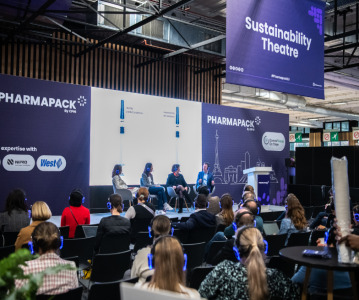2025 Pharma Trends Outlook: Collaborative Pharma – A New Era of Supply Chains
.png)
A new year, a new Pharma Trends Outlook report! The 2025 Pharma Trends Outlook report examines key changes expected in the pharmaceutical industry for the coming year, particularly in regards to the supply chain.
As new ways of working are established in the face of disruptive legislation and increasing efforts to meet sustainability and performance goals, a new era of supply chain efficiency and resiliency is emerging as the pharmaceutical industry shifts its perspectives on collaboration and partnerships.
Supply chain shake ups and reorganisation
The last year has seen several events shake up the pharmaceutical supply chain. From the acquisition of Catalent by Novo Holdings to legislation such as the BIOSECURE Act, the industry is preparing for continued shifts in attitudes and prospective collaborations for 2025. “It’s fascinating to consider the supply chain reconfiguration aspect of this situation,” comments Aurelio Arias, Director at IQVIA. “Ultimately, this reconfiguration of supply chains raises an important question; do policies like these truly reduce reliance on a single country, or do they merely reshuffle dependencies?”
Building supply chain resiliency remains a consistent topic for the entire pharmaceutical industry, whether through continued nearshoring efforts or through legislations like the BIOSECURE Act. Additionally, increased interest in particular drug products such as GLP-1 agonists will certainly have an effect on how the supply chain will adapt to and meet the demands of consumers and patients.
The role of AI in Pharma 5.0
Another trend the 2025 Pharma Trends Outlook report examines is the future of AI use in the pharmaceutical industry, and the implications of patient-centred care on how AI is used and regulated throughout the pharma supply chain. Pharma 5.0 emphasises the importance of the patient in all stages of the drug development, manufacturing, and commercialisation pipeline, as well as improving communication between patients, doctors, and pharmaceutical companies.
While the reliability of AI technologies is still under question, especially as regulators race to establish protocol regarding AI in drug manufacturing, the pharmaceutical industry is also contending with the potential safety concerns arising from separating ‘good’ data from ‘bad’ data. Catarina Abreu, Head of Nutraceuticals at PIPA LLC, states that “The thing to emphasise is that, to develop a successful AI strategy, you must first have the right data. Understanding why something didn’t work is just as important as knowing what does work. This data helps optimise processes, improve supply chains, and reduce costs. It could even lead to better energy management, resource allocation, and time efficiency.” Regulatory focuses for the pharmaceutical industry in response to the consistent interest in AI technologies include fostering collaboration to safeguard public health, promoting harmonisation of regulations, advancing regulatory approaches to encourage innovation, and supporting research for the evaluation and monitoring of AI technology performance.
Establishing a clear data boundary will also be essential for pharmaceutical manufacturers and their partners to understand and utilise the correct and specific data to optimise their processes. “To create reliable AI systems, you first need a deep understanding of the data and the regulations that govern it,” comments Purna Thakker, Founder and CEO of ADPT Solutions. “Only then can you build AI models that are accurate and easy to validate.”
Strategic sustainability
Collaborative strategies will also be evermore important for pharmaceutical companies looking to achieve their sustainability goals in 2025. Partnerships prioritising sustainability goals will affect the kinds of collaborations we will seen in the coming years. Given the complexities of measuring Scope 3 emissions, there is increasing pressure on pharmaceutical and biotech companies to account for the sustainability and emissions across their supply chain, including their contracted partners. Add on the beginning of sustainability policies implemented by local and international governing bodies and it is clear that companies throughout the pharma supply chain will have to be all the more aware of the sustainability credentials of all those they work with.
Want to learn more about which trends will shape the pharmaceutical supply chain in 2025? Download our 2025 Pharma Trends Outlook report here to stay informed.
Related News
-
News US FDA adds haemodialysis bloodlines to devices shortage list
On March 14, 2025, the US FDA published an open letter to healthcare providers citing continuing supply disruptions of haemodialysis bloodlines, an essential component of dialysis machines. -
News Women in Pharma: Manufacturing personal and team success
Our monthly Women in Pharma series highlights the influential lives and works of impactful women working across the pharmaceutical industry, and how the industry can work towards making the healthcare industry and workplace more equitable and inclusive... -
News Pfizer may shift production back to US under Trump pharma tariffs
At the 45th TD Cowen annual healthcare conference in Boston, USA, Pfizer CEO Albert Bourla outlined the potential for Pfizer to shift its overseas drug manufacturing back to the US as pharmaceutical industry players weigh their options against Presiden... -
News Experimental drug for managing aortic valve stenosis shows promise
The new small molecule drug ataciguat is garnering attention for its potential to manage aortic valve stenosis, which may prevent the need for surgery and significantly improve patient experience. -
News Women in Pharma: Connecting accessible pharma packaging to patients – a Pharmapack Special
Throughout our Women in Pharma series, we aim to highlight how CPHI events encourage discussions around diversity, equity, and inclusion initiatives in the pharmaceutical industry. -
News Vertex Pharmaceuticals stock jumps as FDA approves non-opioid painkiller
UK-based Vertex Pharmaceuticals saw their stock shares soar as the US FDA signed off on the non-opioid painkiller Journavx, also known as suzetrigine, for patients with moderate to severe acute pain, caused by surgery, accidents, or injuries. -
News Trump administration halts global supply of HIV, malaria, tuberculosis drugs
In various memos circulated to the United States Agency for International Development (USAID), the Trump administration has demanded contractors and partners to immediately stop work in supplying lifesaving drugs for HIV, malaria, and tuberculosis to c... -
News 2024 Drug Approvals: a lexicon of notable drugs and clinical trials
50 drugs received FDA approval in 2024. The centre for biologics evaluation and research also identified six new Orphan drug approvals as under Biologics License Applications (BLAs). The following list picks out key approvals from the list, and highlig...
Recently Visited
Position your company at the heart of the global Pharma industry with a CPHI Online membership
-
Your products and solutions visible to thousands of visitors within the largest Pharma marketplace
-
Generate high-quality, engaged leads for your business, all year round
-
Promote your business as the industry’s thought-leader by hosting your reports, brochures and videos within your profile
-
Your company’s profile boosted at all participating CPHI events
-
An easy-to-use platform with a detailed dashboard showing your leads and performance








